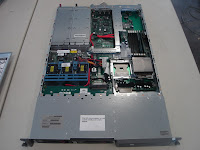 I came across the Acer Aspire easyStore H340 while surfing the Internet today. On the surface it looked like a pretty nice little atom based home server for about $400.
I came across the Acer Aspire easyStore H340 while surfing the Internet today. On the surface it looked like a pretty nice little atom based home server for about $400.
Acer states: "Put your photos, music, video and important documents all in one place. The Aspire easyStore H340 Home Server holds up to 500,000 digital photos, 300,000 MP3 files and 4,285 hours of movies (based on 3MB per photo, 5MB per MP3 file and 350MB per hour playing time)."
"Protect you vital documents and precious family photos from PC or hard drive failure. The easyStore automatically saves a copy of important files from every computer connected to it."
Digging deeper into the specifications revealed this unit has a personality crisis, It is running Windows Home Server but as its name implies it is being sold as a simple NAS with a 1TB hard drive and backup capabilities vs. a full blown home server.
A review of the specifications also revealed its running on a Atom 230 single core processor, will only support Microsoft clients and can only accept a maximum of four 1TB drives. 4TB should be more than enough for home users but why put a limitation on drive size when 2TB drives are shipping?
The The new HP MediaSmart Server also has some of the same problems as the Acer easyStore. The LX195 has a $399 suggested retail price, runs Windows Home Server, and uses the Atom 230 processor, 1GB of RAM, 640GB 7,200-RPM hard drive, one Gigabit Ethernet port, and four USB ports. You can substitute the 640GB hard drive for a higher-capacity option, but the only way to add more storage is by adding USB external drives. No Serial ATA RAID in other words.
 I finally pulled the trigger and purchased my 4th HP DL360 Proliant Server for my brother-in-laws growing IT system. This new sever will be used as an email server running SME Server 7.4. I guess it is the nerd in me but I am always amazed at how much technology you can purchase for so little if you are willing to shop around.
I finally pulled the trigger and purchased my 4th HP DL360 Proliant Server for my brother-in-laws growing IT system. This new sever will be used as an email server running SME Server 7.4. I guess it is the nerd in me but I am always amazed at how much technology you can purchase for so little if you are willing to shop around.













